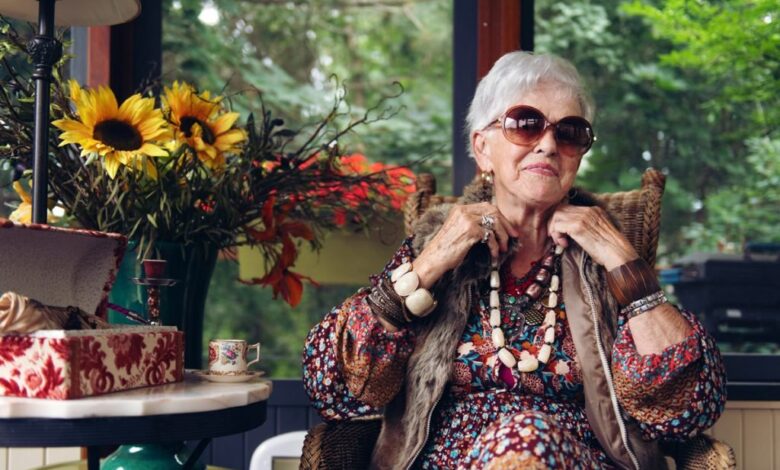
How to Identify Vintage Costume Jewelry and Make Money From It
[ad_1]
As anyone who has accumulated a collection of jewelry knows, there’s nothing like the detritus in drawers, boxes and overflowing jewelry boxes. Amid the diamonds and opals, the silver and gold (OK, if you’re lucky), lies a different kind of beauty — the beauty of costume jewelry.
While costume jewelry often gets short shrift compared to precious stones and metals, vintage jewelry sellers reap the benefits of this misconception. It turns out that there is much value to be found in costume jewelry, if only the buyer — of the grandkid — knows how to identify vintage jewelry.
You may come across costume jewelry in several ways. You might get a tangle of necklaces, rings, brooches and bangles as an inheritance. Perhaps you were lucky enough to get faux pearls and rhinestones as gifts over the years. Or maybe you’re a newbie junker or have started going to estate sales looking for silver and gold but are wondering about the value of jewelry that isn’t.
Contents
What Is Costume Jewelry?
Costume jewelry — sometimes called fashion jewelry — is generally mass produced. It can be made of many materials, including plastic, but typically not precious metals, especially gold.
The phrase costume jewelry became popular in the 1930s and the jewelry itself provided a way for women to adorn themselves for less money. Think dripping with jewels, just not diamonds, rubies and emeralds and instead amethyst, amber, turquoise and onyx.
Now, some of that retro vintage costume jewelry is worth some money, especially when it is from a reputable designer. Jewelry stamped with the manufacturer or designer’s name is almost always worth more than unsigned pieces.
Bakelite bangles, necklaces and pins are a good example of how costume jewelry has increased in value. The fire-resistant, castable plastic was made into chunky, colorful jewelry (and napkins rings, too) in the 1930s and 40s. If you’ve found some Art Deco delights in Grandma’s jewelry box, know that a Bakelite bangle could be worth $100 or more. Found a funky pin? That might be $500.
11 Tips on How to Identify and Sell Vintage Costume Jewelry
When faced with a crowded jewelry box, it’s hard to find meaning in any of it. Learning how to identify vintage costume jewelry is the first step.
How do you know which pieces to keep and with which to part ways? We interviewed two jewelry sellers who have turned a significant profit through their sales. Laura Clarice Webb, who runs London-based Clarice Jewellery, once purchased a brooch for 22 pounds (about $30) and sold it for 700 pounds (about $950) that same day.
While beginners probably won’t get that far immediately, there are some important standards to keep in mind on your journey, even if that first step is going through Grandma’s old jewelry box.
Jennifer Ward owns vintage jewelry business Ward Vintage and is based in Bernardsville, New Jersey and deals primarily with costume jewelry,
Keep in mind that what was in fashion back then sometimes comes around again and at a profit. So before you dump that 1950s hideous rivoli stone brooch that Grandpa got Grandma in the 1950s, know that someone might just pay $50 for it. Likewise the Monet earrings your best friend gave you as a gift for being an attendant in her 1976 wedding.
Here are their 11 tips to determine if those prized jewels worn with pride are worth something and how to sell them if they are.
1. If You See Something Nice, Double Check
While this post is about costume jewelry, we have an important caveat: if you have jewelry that could be made of precious metals and stones, check it out with a jeweler, Ward said.
Ward will sometimes work with buyers who leave a bulk jewelry collection to her. It’s grueling to go through pieces one by one, but diamonds in the rough — pardon the expression — do emerge. She once took a set of earrings to a jeweler and discovered that they were 14-karat gold. The jeweler said they wouldn’t sell them for less than $1,000.
Most local jewelers are willing to look at items for no cost or low cost, according to Ward. It’s worth forming that relationship now so you know where to go when you do have a question. And if you already know some of your antique jewelry is precious, here are our best tips for selling right away.
Sample Costume Jewelry Prices
2. Do Research on Where to Sell Antique Jewelry
Both Ward and Webb couch their answers in qualifiers, but much of their online business happens on Instagram. Ward stages and posts some of her most eye-catching items on the social media platform, though many of the actual financial dealings happen off of the app.
Webb likes Instagram’s community-based atmosphere. With a few simple hashtags, like #vintagejewelry or #antiquerings, she can tap into a global community.
“Instagram is just so easy and a relaxed way of just sharing what you have,” she said. “I feel like if someone was starting and they had a range of jewelry, you can pick a few of the right hashtags and there are thousands willing to buy and share knowledge.”
3. Be Prepared to Sift Through Retro Pieces and Other Items
Part of the fun of going to a thrift store, flea market or estate sale is that it can feel like a bit of a jungle. Don’t expect to enter and find 30 things you want within the first 15 minutes. It takes some time — and a good eye — to find what you want, according to Ward.
“You have to be willing to sift through a lot of junk,” she said. “It’s not like you’re going to go in and get 10 things.”

4. The Materials of Vintage Jewelry Matter
Don’t immediately discard costume jewelry that seem out of style or don’t instantly scream luxury. In fact, Webb is a big advocate of glass material items. You don’t have to find fine materials for a piece to be worth something.
“If someone finds something and it is glass, don’t be deterred,” she said. “Just because it’s glass doesn’t mean it’s worthless.”
5. Build Relationships With Sellers and Buyers
Both Ward and Webb have relationships with customers and dealers to get the best pieces out to the right people. Ward texts back and forth with dealers of vintage and costume jewelry. She has Zoom meetings to see the best pieces. Do I want this one or that one, she wonders.
If you are looking to unload family antique jewelry, this might not be as big a concern for you since it may be a one-time adventure. However, if you want to build an antique jewelry business, relationship building is key.
Webb has met numerous people through her journeys to antiques fairs. While the business connections are important, it’s the passion that inspires her. These are good people to seek advice from when you’re first starting out.
“There are so many people who you can tell they’re not making a lot of money, but they just love what they do,” she said. “It keeps them going.”
6. Look for a Signature or Other Makers Mark
One no-fail bit of advice to find a piece that will earn at least a little money: spot the signature or the marked piece. It’s not just items by name-brand designers that attract buyers at top dollar — it’s recognizable American brands, like Monet and Napier. The key is to find things that represent certain time periods and may appeal to collectors.
Even if you don’t see a signature, so essentially if you have what you believe to be unsigned pieces, look for a maker’s mark, says Webb. That could be a small animal or a symbol that explains the jewelry’s lineage. Invest in a magnifying glass because some of those marks can be quite small.
“Even if it’s not precious metal or precious stone, it may still have a mark,” Webb said. “If you Google it, you’ll usually find someone somewhere who has done the research.”

7. If It Looks Quality, It Probably Is
Sometimes determining if a costume jewelry necklace or other piece is high-quality is as easy as picking them up.
“Good costume jewelry has a weight to it,” Webb said. Ask yourself, are they heavy for their size?
Many of the older pieces were triple-plated, according to Ward. Even costume jewelry that looks well-made is likely more valuable, she said.
8. Be Wary of Fakes
The world of jewelry and jewelry identification is not without its risks. Webb knows this well: she will no longer purchase vintage costume jewelry by Chanel, because there are so many fakes. In fact, she once spent about $275 on a pair of earrings only to learn they were fake.
“They are of such a good standard that I don’t think I would be able to tell whether some of them are real or not,” she said. “It’s not worth investing the money because it’s too much of a risk.”
9. Understand Which Jewelry Pieces Are Good Sellers
When Ward scouts the shelves for good jewelry, there are certain things that always catch her eye. She is less focused on design and more focused on type which helps her determine value.
For example, so many vintage earrings are clip-ons, so when she finds vintage earrings meant for pierced ears, she grabs those. That’s because so many people — about 85% — have pierced ears and if the earrings are meant for pierced ears, the buyer doesn’t have to take them to a jeweler to be altered. In other words, they are more likely to buy vintage earrings they can wear right away.
Charm bracelets are ever popular — think Pandora but vintage jewelry. European designer jewelry made by Givenchy, Christian Dior and, yes, Chanel will always sell.
10. Know What Your Clients Want
Just as building relationships with vendors is key, so is building relationships with clients who shop for specific styles on vintage jewelry or costume jewelry collectors. Ward is at a point where she can identify certain pieces for certain clients. Sometimes, that means straying from purchasing things just based on what she would want to wear.
“I still buy what I like, but it’s not necessarily what I would wear,” she said.
11. Create a Brand and Internet Presence
If you want to be really successful in the vintage jewelry business, then the same thing holds true as with any other line of work: build a personal brand. Webb makes most of her sales through her website, and much of that is through her weekly newsletter.
That email chain has 600 subscribers and a whopping 70 to 80% click rate — the average for most newsletters is less than 20 percent. Her subscribers are engaged and ready to peruse her newest listings. Most of her items go fast.
“The newsletter is my biggest achievement, because it’s all been through people choosing to sign up,” she said. “That’s the key to success.”
Writer Elizabeth Djinis is a contributor to The Penny Hoarder, often writing about selling goods online through social platforms. Her work has appeared in Teen Vogue, Smithsonian Magazine and the Tampa Bay Times.
[ad_2]





